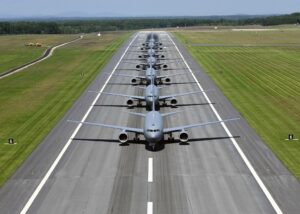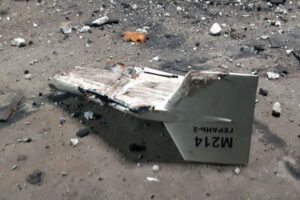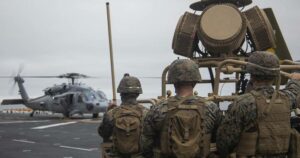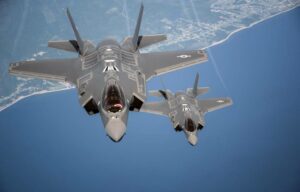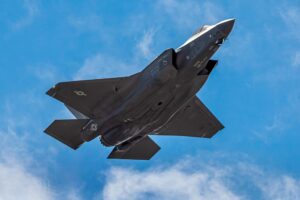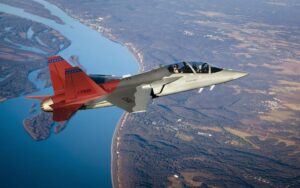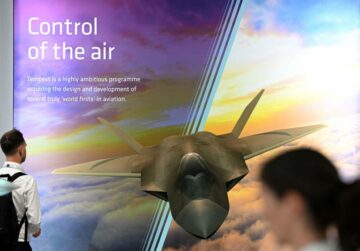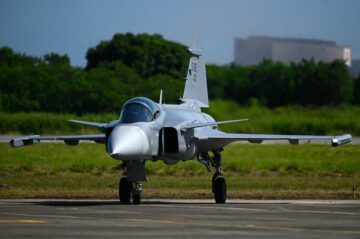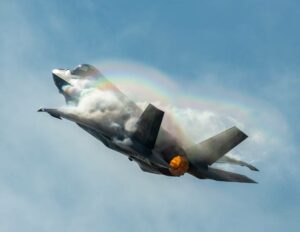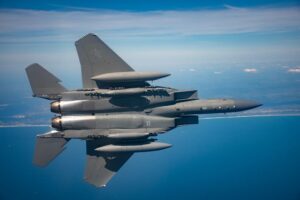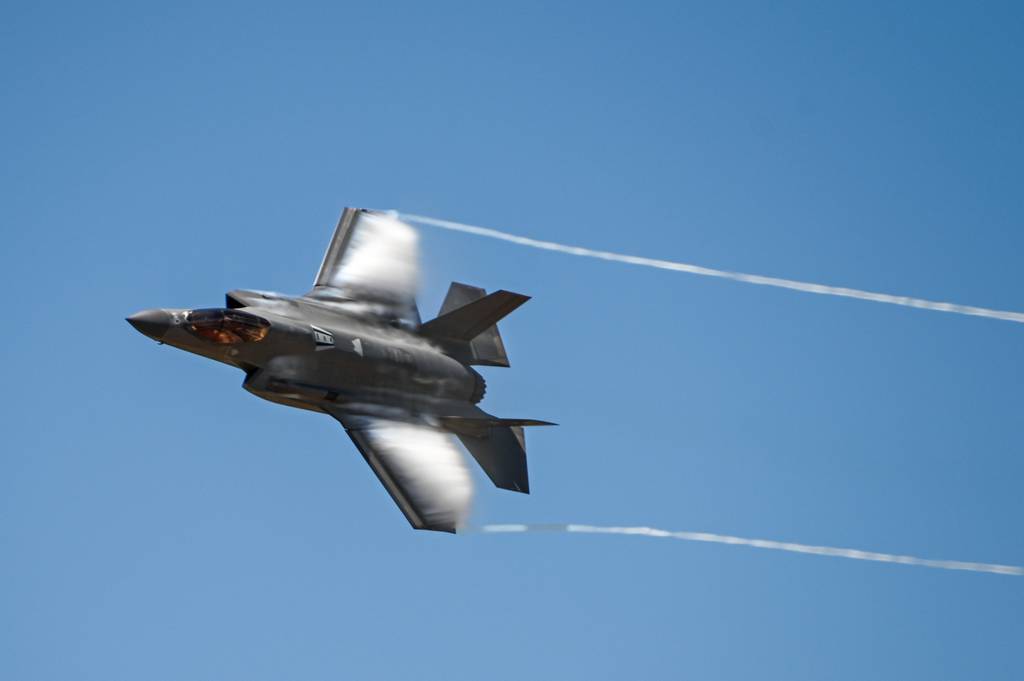
WASHINGTON — Problems with the F-35 Joint Strike Fighter’s newest upgrades will cause the aircraft’s manufacturer to miss its 2023 delivery goal by up to roughly 50 jets, Lockheed Martin officials said Tuesday.
The delays could bring down Lockheed’s revenue for 2023 by hundreds of millions of dollars.
Lockheed originally planned to deliver between 147 and 153 fighters this year. But software problems with the upgrades known as Technology Refresh 3, or TR-3, are causing significant delays. The Pentagon announced in June that it would not accept newly built F-35s with TR-3 until the upgrades are completely ready.
Lockheed CEO Jim Taiclet said in an earnings call with investors Tuesday that the company now expects to deliver 100 to 120 F-35s this year, given the TR-3 software issues.
Jay Malave, Lockheed’s chief financial officer, said the delivery delays will cost the firm between $210 million and $350 million this year, depending on how soon the company can start delivering fighters enabled with TR-3.
However, the company has not slowed production on the F-35, Malave added, and will store completed jets until they’re ready for delivery.
“There won’t be a production lag,” Malave explained. “There’ll be just a delivery lag based on the completion of the software integration testing that has to be done in the air.”
Next year, he added, Lockheed will likely end up delivering more than the 156 fighters it previously planned to build and deliver in 2024.
“Our team remains fully dedicated to delivering the first TR-3 aircraft in 2023,” Taiclet said. “We have completed 58 flight tests on four different aircraft in the TR-3 configuration, including a successful flight test for the most recent software release that happened in May.”
TR-3 is the program’s name for a package of upgrades that are intended to give the F-35 better displays, computer memory and processing power, and is necessary before a more extensive modernization known as Block 4 can be added. Block 4 will allow the F-35 to carry more long-range precision weapons, improved electronic warfare capabilities and better target recognition.
The U.S. Air Force in January conducted the first test flight of a TR-3-enabled F-35.
But the schedule for rolling out TR-3, originally due in April 2023, has slipped. The F-35 Joint Program Office now expects it to arrive in December 2023 at the earliest, or perhaps April 2024.
Development and initial production of TR-3′s hardware was originally slow, the F-35 Joint Program Office said, but hardware issues are now resolved. Lockheed Martin is now building F-35s with TR-3 hardware installed.
But the JPO said last month that TR-3′s software, and getting it to work with the fighters’ new hardware, is proving difficult. Taiclet first said the TR-3 issues would lead to fewer deliveries in an April earnings call, but at that time described the scope of the problem as a “fraction” of the total 2023 deliveries and said it was expected to have “little to no” effect on the company’s aeronautics revenues or profits.
Tuesday’s comments were the company’s first that indicate the full scale of the delivery halt’s impact.
The Pentagon is still accepting deliveries of TR-2-enabled F-35s. Taiclet said the company delivered 50 such F-35s in the first half of the year.
Malave said the company is running extra shifts and sending its experts to other businesses and suppliers to ensure the F-35 program stays on track. He also noted Lockheed and the Defense Department have enough pilots to conduct acceptance flights to clear those newly built jets for delivery once they are ready.
Lockheed expects to get back to delivering 156 F-35s annually in 2025, Taiclet said.
Stephen Losey is the air warfare reporter for Defense News. He previously covered leadership and personnel issues at Air Force Times, and the Pentagon, special operations and air warfare at Military.com. He has traveled to the Middle East to cover U.S. Air Force operations.
- SEO Powered Content & PR Distribution. Get Amplified Today.
- PlatoData.Network Vertical Generative Ai. Empower Yourself. Access Here.
- PlatoAiStream. Web3 Intelligence. Knowledge Amplified. Access Here.
- PlatoESG. Automotive / EVs, Carbon, CleanTech, Energy, Environment, Solar, Waste Management. Access Here.
- BlockOffsets. Modernizing Environmental Offset Ownership. Access Here.
- Source: https://www.defensenews.com/industry/2023/07/19/f-35-delivery-delays-to-cost-lockheed-hundreds-of-millions-in-2023/
- :has
- :is
- :not
- $UP
- 10
- 100
- 2023
- 2024
- 2025
- 50
- 70
- a
- Accept
- acceptance
- accepting
- added
- Aeronautics
- AIR
- Air Force
- aircraft
- allow
- also
- an
- and
- announced
- Annually
- April
- April 2024
- ARE
- AS
- At
- back
- based
- BE
- before
- Better
- between
- Block
- bring
- build
- Building
- built
- businesses
- but
- by
- call
- CAN
- capabilities
- carry
- Cause
- causing
- ceo
- chief
- Chief Financial
- chief financial officer
- clear
- COM
- comments
- company
- Company’s
- Completed
- completely
- completion
- computer
- Conduct
- conducted
- Configuration
- Cost
- could
- cover
- covered
- December
- dedicated
- Defense
- Defense Department
- delays
- deliver
- delivered
- Deliveries
- delivering
- delivery
- Department
- Depending
- described
- different
- difficult
- displays
- dollars
- done
- down
- due
- Earnings
- earnings call
- East
- effect
- Electronic
- enabled
- end
- enough
- ensure
- expected
- expects
- experts
- explained
- extensive
- extra
- fewer
- fighters
- financial
- Firm
- First
- flight
- Flights
- For
- Force
- four
- full
- fully
- get
- getting
- Give
- given
- goal
- Half
- happened
- Hardware
- Have
- he
- How
- HTTPS
- Hundreds
- hundreds of millions
- images
- Impact
- improved
- in
- Including
- indicate
- initial
- integration
- intended
- Investors
- issues
- IT
- ITS
- January
- Jets
- Jim
- joint
- jpg
- june
- just
- known
- Last
- lead
- Leadership
- likely
- Lockheed Martin
- Manufacturer
- Martin
- May..
- Memory
- Middle
- Middle East
- Military
- million
- millions
- modernization
- Month
- more
- most
- name
- necessary
- New
- new hardware
- Newest
- newly
- news
- noted
- now
- of
- Office
- Officer
- officials
- on
- once
- Operations
- or
- originally
- Other
- out
- package
- pentagon
- perhaps
- Personnel
- Pilots
- planned
- plato
- Plato Data Intelligence
- PlatoData
- power
- Precision
- previously
- Problem
- problems
- processing
- Processing Power
- Production
- profits
- Program
- ready
- recent
- recognition
- release
- remains
- reporter
- resolved
- revenue
- revenues
- Rolling
- roughly
- running
- s
- Said
- Scale
- schedule
- scope
- sending
- Shifts
- significant
- slow
- Software
- Soon
- special
- start
- Still
- store
- strike
- successful
- such
- suppliers
- Target
- team
- test
- Testing
- tests
- than
- that
- The
- they
- this
- this year
- those
- time
- times
- to
- Total
- track
- traveled
- Tuesday
- u.s.
- U.S. Air Force
- until
- upgrades
- was
- Weapons
- were
- will
- with
- Work
- would
- year
- zephyrnet

